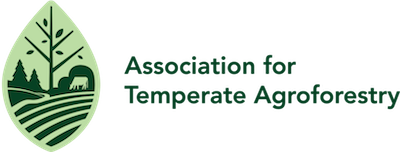| |
Hello Visitor,
Welcome to the August 2018 version of the Temperate Agroforester. The newsletter welcomes contributions for future issues and input or feedback about anything that you read in this issue.
Uma Karki, Christine C. Nieman, Steve Gabriel, Diomy Zamora and Callie Maron, Editors - Temperate Agroforester
Events
2019. 16th North American Agroforestry Conference. Willamette Valley, Corvallis, Oregon.
Call to Action
AFTA needs you! We need your research updates, blog posts, news items and other information to inform our followers. Contact: Andres Anchondo. We are also looking for volunteers to help with membership engagement and website content. Volunteer today to help keep AFTA moving foward.
Membership
Are you a member of AFTA? If not consider joining by clicking here. Your membership gives you access to the members-only area, discounts on conference registration, and helps support AFTA's mission to promote agroforestry.
Contents
Erin Lane, USDA Northeast Climate Hub and Kate MacFarland, USDA National Agroforestry Center, US Forest Service, edlane@fs.fed.us
 Climate change is already impacting farm and forest lands throughout the northeastern United States. Temperatures are increasing and more rain is falling all at once with dry periods in between. With these changes comes greater variation and uncertainty in crop and livestock production. Without modifying management, agricultural profits may decline (Melillo et al. 2014). Farmers and land managers are finding ways to adapt to the ongoing changes. Sharing experiences cultivates new ideas and techniques for reducing risk or taking advantage of new conditions. Field visits are a powerful way to view a practice in action before considering it for your land. Through virtual demonstrations you can leave your field boots behind and take a tour from your desk, ‘as if you were there’ in the field.
Read More
Alexander Darr, Virginia Tech, Dr. Jeffrey Kirwan, Virginia Tech
 Despite our understanding that perennial agriculture has been practiced globally for millennia, understanding of North American indigenous agroforestry systems remains poor. It is a widely-held belief among the public that indigenous North Americans limited their agricultural production to annual crops, while opportunistically foraging for the fruits of perennials in the matrix of wilderness surrounding their settlements. However, clues from early European contacts with indigenous civilizations of the modern day United States, as well as corroboration from archaeological evidence, point towards an intensive, and widespread perennial polyculture managed in the vicinity of permanent settlements. (Abrams & Nowacki 2008)
Read More
Gary Bentrup, USDA National Agroforestry Center, Lincoln, NE gbentrup@fs.fed.us
Read More
Christine Laporte Consultant, Sacharuna Foundation, Asheville NC
 The Appalachian Mountains are a global hotspot for biodiversity, including many plant species with a long history of medicinal, culinary, and decorative usage and economic value. Unfortunately, native wild populations of these plants are experiencing heavy overharvesting pressures and widespread habitat destruction, leading to serious declines. Recently, the International Union for Conservation of Nature listed Goldenseal (Hydrastis canadensis, Figure 1) as “Vulnerable to Extinction” due to unregulated wild-harvesting, and significant loss of forest habitat (IUCN 2017). The World Wildlife Fund reports that ~83% of the habitat in this ecoregion has been altered (Loucks et al. 2017). These pressures impact many Non-timber Forest Product (NTFP) species, and there is an urgent need to transition from the historically extractive, cash-economy model to a regenerative model.
Read More
Stephanie Chizmar, Frederick Cubbage, Erin Sills, Robert Abt, Rajan Parajuli, and Miguel Castillo
 Silvopasture, a strategic and managed agroecosystem, integrates livestock, forage, and trees or shrubs to improve individual components (Orefice and Carroll 2017; USDA National Agroforestry Center [NAC] 2012). Chizmar (2018) calculated potential returns to silvopastoral systems with Angus cattle and loblolly pine (Pinus taeda). Data were drawn from a field trial in the Coastal Plain of North Carolina (Figure 1) under various assumptions about the relationships between system components.
Read More
James A. Allen, Professor and Executive Director, School of Forestry, College of Engineering, Forestry and Natural Sciences, Northern Arizona University
 The first edition of Temperate Agroforestry Systems, an edited volume by Andrew Gordon and Steven Newman, was published in 1997 (Gordon and Newman 1997). This was an important contribution, but there has been much progress on the science and application of agroforestry in temperate regions over the past 21 years. I was therefore pleased to have a chance to review the second edition of this book, which has a publication date of March 2018 (Gordon et al. 2018; Figure 1).
Read More
|
|






